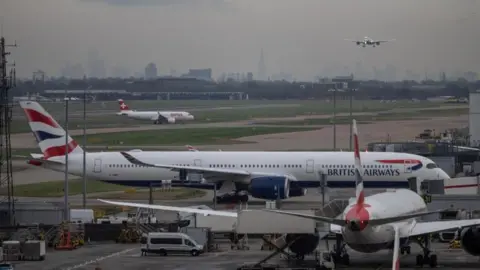On a Wednesday marked by significant frustration for travelers, airlines and airports across the United Kingdom issued warnings about anticipated delays following a serious glitch in the air traffic control system. The technical problem experienced by the UK air traffic control service, known as NATS (National Air Traffic Services), was reported to have caused extensive disruption, grounding flights at major airports including Heathrow, Stansted, Manchester, and Edinburgh.
The glitch occurred earlier in the day, prompting NATS to immediately take action, effectively grounding thousands of planes and limiting departures to ensure safety in the airspace. This unsettling situation lasted roughly 20 minutes before the technical issue was resolved around 5:10 PM. As a result, while air traffic resumed, the repercussions of the outage continued to be felt as both airlines and airports faced a backlog of flights needing to be cleared.
In the wake of the disturbance, NATS communicated that they were working diligently with affected airlines and airports to manage the situation safely and efficiently. At the time of the outage, the Swanwick air traffic control center had been particularly impacted, forcing NATS to limit aircraft movements in the London airspace. This decision caused considerable disruption at various airports, with Gatwick confirming that it had also grounded all outgoing flights due to the complications.
Both affected airlines and airport officials quickly began addressing the concerns arising from the glitch. For instance, British Airways publicly acknowledged the situation, expressing their understanding and sympathy toward customers inconvenienced by the delays. The airline emphasized that while the outage was entirely beyond their control, they were focused on assisting travelers in getting back on track as swiftly as possible.
A representative from Heathrow airport echoed these sentiments, advising passengers to check directly with their airlines for real-time updates about flight statuses. NATS further expressed regret, apologizing to all travelers impacted by the operational hiccup.
This incident marks the second major outage experienced by NATS in a span of just two years. The previous disruption occurred during a summer bank holiday weekend in 2023, affecting an estimated 700,000 passengers. The frequency of these outages has raised considerable concern within the travel industry, prompting immediate calls for accountability. Ryanair’s chief operating officer, Neal McMahon, articulated his outrage over the recurrence of air traffic control issues, putting pressure on NATS’s leadership by demanding the resignation of its chief executive, Martin Rolfe.
As delays began to ripple through the air travel network, information on flight statuses became paramount. Airports found themselves in a race against time to communicate any updates regarding the resumption of operations and the anticipated wait times. Passengers, many of whom were already in transit, faced uncertainties regarding their travel plans.
Overall, Wednesday’s air traffic incident in the UK underscores the intricate web of dependencies within air travel logistics. From the coordination required among air traffic controllers to airlines and airports to the ultimate impact on passengers, a single technical failure can quickly amplify into extensive delays across a broad network. As NATS works to restore normalcy and clear the backlog, the focus on enhancing the reliability of air traffic control systems will likely come under scrutinization, emphasizing the need for robust contingency planning within the air travel industry.












